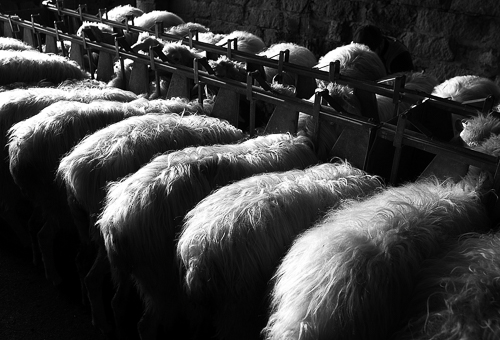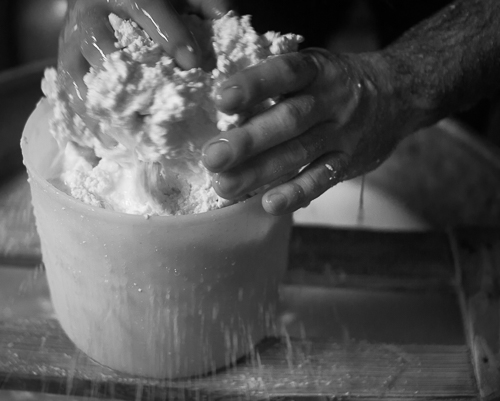We met Salvatore Porcu following his sheep across the panoramic road between Alghero and Bosa in the region of Sedduri. Following the northeastern coast of Sardinia, the views from the road were really spectacular.
Here, between the road and the sea, is located a shed owned by the Porcu brothers, Salvatore and Giovanniantonio, who also own the area below and above the shed stretching all the way to the mountains high above us. The landscape consisted of valleys covered with meadows and Mediterranean maquis situated on steep mountain sides.
After having asked Salvatore if I could photograph the milking of the sheep, he accepted my not so good Italian immediately, just pointing at the shed and saying that we could drive down there. After having received such a friendly welcome, we of course did as we were told. After having first passed some free-ranging pigs, we entered the long and narrow shed, where we could watch the sheep entering the shed and that most of them found a space to reside without aid. Of course, some sheep needed guidance, but after having positioned everyone in their place, one of the shepherds locked the heads of all the sheep simultaneously by means of some mechanical device. Then, Giovanniantonio who has studided veterinary sciences and has a special interest in the welfare of their animals, poured feed for the sheep into a trough such that all the sheep had something to eat. Since all the sheep had their heads locked fast and they were busy eating, Salvatore and Giovanniantonio could, with the aid of a friend, milk about 150 sheep in just a few minutes. After having made the sheep exit one end of the shed, the second group of sheep were waiting in the other end, ready to be milked.
All the sheep are milked twice daily, morning and evening, and after having finished the milking in the morning, all the milk is transported to a tiny dairy located in the house of the Porcu family where the milk is turned into cheese and ricotta. Before adding rennet, that is a compound consisting of enzymes having been mainly extracted from calves’ stomachs, the milk is heated to about 36°C before letting it rest for about 25-30 minutes. If you want to turn the milk mass into a cheese called fiore sardo (Sardinian flower), you should start working the curd immediately, that is putting it into small cylindrical containers. I f you, instead, want to make a cheese called semicotto, the temperature of the curd has to be raised to 42°C. Then, the curd is again lifted into small, cylindrical containers. In both cases, Salvatore pressed the curd in the containers manually, in order to let the whey exit, since a cheese should contain the fat parts and not the liquid parts of the milk. Then, he placed the small containers on an incline such that the whey would be transported back to the big container, from which the cheese mass had been taken, by means of gravity. In the meantime, Salvatore heated the remaining milk, containing mostly liquid, up to 90°C when small lumps of fat started surfacing. This liquid is used as a supplement to the mainly vegetarian food their pigs are usually eating.
Salvatore learnt how to produce cheese from his father and years of practice has turned him into one of the best producers of semicotto in his region. A main contribution to the high quality of the cheese they are producing, is the feed their sheep are eating. Besides eating herbs growing in the wild, they are also fed organic cereals. Since they are able to roam freely between the sea and high into the mountains, they are also able to eat a diverse range of plants, which will of course improve the quality of the milk they are producing.
Place of milking the sheep: the Sedduri region



